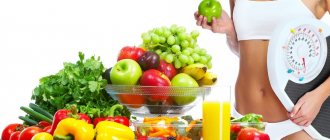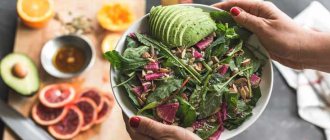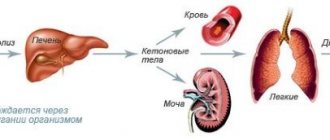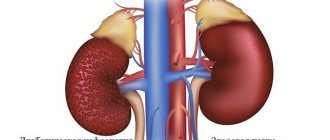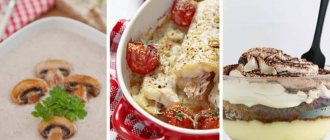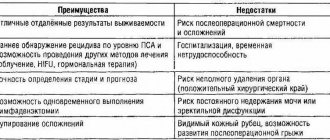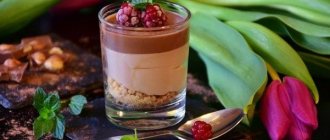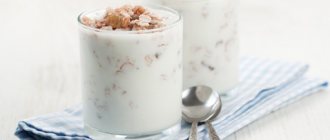A healthy pancreas secretes the hormone insulin, which removes excess sugar in the blood. Part of the glucose supplied by food is consumed by the muscles during physical activity. Functional disturbances in the organ responsible for producing insulin lead to elevated glucose levels, which leads to many other health problems.
Since carbohydrates come to us through food, it is logical to assume that the right decision would be to limit their intake. We will tell you in this article what nutrition and diet should be like for type 2 diabetes so that sugar does not rise.
Consequences of the disease
Diabetes is an insidious and dangerous disease. It is the main cause of blood clots, as well as strokes and heart attacks. The disease affects the organs of the excretory system and leads to the destruction of the human natural filter - the liver. Vision suffers, since high sugar provokes the formation of glaucoma or cataracts.
For a patient with carbohydrate metabolism disorders, diet should become a way of life. Let's start with what sugar level is considered normal. The ideal value is 3.2 to 5.5 mmol/l.
An increase in blood sugar levels can land a patient diagnosed with type II diabetes in a hospital bed, sometimes even in an unconscious state.
This happens if the glucose level reaches a critical value of more than 55 mmol/l. This condition is called coma. Depending on what causes it, there are:
- ketoacidotic,
- hyperosmolar,
- lactic acidemic coma.
The first is caused by an increased content of ketone bodies in the patient’s blood, which are a product of the breakdown of fats and proteins. The cause of ketoacidotic coma is a lack of energy obtained from the breakdown of carbohydrates. The body uses additional sources - fats and proteins, the excess of breakdown products of which has a toxic effect on the brain. By the way, low-carb diets can also lead to a similar effect, which is why it is so important to stick to a balanced diet.
Hyperosmolar coma is a rarer occurrence. It usually develops against the background of concomitant infectious diseases. Its cause is intense dehydration, which leads to blood thickening and a comprehensive disruption of the functioning of the vascular system. This condition develops when the sugar content exceeds 50 mmol/l.
Lactic acidemic coma is a rare phenomenon. It is caused by increased levels of lactic acid. This substance has a pronounced cytotoxic effect, that is, it leads to damage to cellular structures with subsequent death. It is this condition that is considered the most dangerous complication of diabetes, since it leads to dysfunction of the entire vascular system and can result in the death of a person if qualified assistance is not provided in a timely manner.
Type 2 diabetes
He is called insulin-independent. Glucose in the blood increases, but this is due to the fact that insulin’s interaction with the body’s tissues is impaired.
This type of diabetes causes severe weight gain, increased appetite, frequent pain and metabolic system disorders.
Principles of nutrition
The diet for diabetics follows the same rules as the healthy diet of an ordinary person. The menu does not include any exotic products. On the contrary, the simpler the food, the better. Diabetics are advised to eat every 3.5 hours. This is exactly the amount of time needed for what was eaten earlier to be absorbed. It is better to set breakfast, lunch and dinner by the hour. Snacks are not limited in time. Their purpose is to reduce the feeling of acute hunger.
Obese patients, and these are the majority of diabetics, are prescribed a low-calorie diet, the energy content of which falls within 1300-1500 kcal.
By the way, a diet for diabetics, consisting of foods with a low glycemic index, is perfect for those losing weight.
It allows you to lose weight without food breakdowns, unbearable feelings of hunger, comfortably and smoothly.
The calorie content of the daily diet is distributed as follows. Breakfast, lunch and dinner account for 25, 30 and 20% of food intake, respectively. The remaining 25% is divided between two snacks. The main portion of carbohydrates, most often porridge made from millet, buckwheat or oats, comes at the first meal. Dinner for a type 2 diabetic consists of protein foods (cottage cheese, chicken, fish) and a portion of vegetables (fruits, berries). It is not recommended to take too long a break from eating. Before going to bed, you need to drink a glass of kefir, milk, and vegetable juice. It is better to have breakfast as early as possible, around 7-8 am.
A diabetic's menu must certainly contain vegetables: root vegetables, cabbage of all types, tomatoes. Foods with a high proportion of fiber fill the stomach, creating satiety, but at the same time contain a minimum of calories. Desserts are also not prohibited for diabetics. Unsweetened apples, pears, and berries are suitable for this purpose. But you need to be very careful with honey and dried fruits, they contain too many calories. Foods such as bananas, melon, watermelon, and grapes are limited in consumption.
Protein foods are the main component of the menu for a disease such as diabetes. But animal products often contain a large amount of fat, which also has to be carefully monitored.
For example, you should not eat too many chicken eggs. Recommended quantity: 2 pieces per week. However, keep in mind that only the yolk is dangerous; the white omelet can be consumed. We have to cut back on meat: lamb, pork, duck, goose. A large amount of fat is contained in offal - liver or heart. You need to eat them rarely and little by little. The chicken should also be processed before cooking, removing excess (skin, fatty layers). Dietary meats include rabbit, turkey, and veal. Fish, especially sea fish, is good for diabetics; its fat contains omega acids that are beneficial for blood vessels and the heart.
Too salty foods, smoked meats, fried foods, fast food, and instant food are strictly contraindicated. Sodium chlorine should be limited to 4 g per day. You should not eat baked goods or confectionery products made with sugar. Of course, alcoholic drinks, even light ones, are also not recommended for diabetics.
Be sure to check out the alternative approach that a low-carb diet offers diabetics.
Prohibited Products
Sugar has an average GI level, but of limited value. The list of prohibited products includes:
- flour;
- toast;
- soft baguette;
- watermelon;
- waffles and other sweets;
- cakes;
- fried potatoes;
- white and rice bread.
Important! Do not add hot spices during cooking.
You should exclude cream, full-fat yogurt, sausage, fatty fish or herring from your diet. You cannot eat at fast food establishments.
Sweets contribute to a sharp deterioration in well-being
Weekly menu
As we said earlier, proper nutrition for type 2 diabetes for the common people is represented by affordable products. The menu is dominated by cereals, vegetables, herbs, and chicken. It should be noted that exotic dishes on a diabetic’s menu are not very appropriate, and many of them are simply contraindicated. The exception is seafood, but they will be completely replaced by the usual and no less tasty herring. The menu for each day is compiled taking into account calorie content and the correct ratio of nutrients. Dishes from the presented list can be combined randomly.
Breakfast to choose from:
- Hercules porridge with water, carrot juice.
- Cottage cheese with carrots, tea with lemon.
- Steamed or baked cheesecakes, chicory drink with milk.
- Protein omelet cooked in a sleeve, decaf coffee.
- Millet porridge with raisins and dried apricots, tea with milk.
- A couple of soft-boiled eggs, tomato juice.
- Vanilla curd casserole with raisins, rosehip drink.
Lunch options for the week:
- Pea soup, vinaigrette, apple compote with sorbitol.
- Lentil soup with herbs and garlic, cabbage and carrot salad, a piece of boiled chicken, apricot compote.
- Vegetarian borscht, buckwheat with mushrooms, rosehip infusion.
- Cauliflower soup, steamed chicken meatballs, cranberry juice.
- Green cabbage soup made from spinach, seasoned with half an egg, buckwheat porridge with champignons and onions,
- Vegetable soup with celery, brown rice with green peas, tomatoes and garlic, apple juice.
- Fish soup with added millet, boiled fish, cucumber and radish salad. Pear compote with stevia.
Preparing first courses for diabetics has its own characteristics. They do not put potatoes in soups; they are cooked in vegetable broth, and they do not fry vegetables. The serving is 300 milliliters, you can add a couple of pieces of dark bread to it.
Fruits, nuts, berries, and unsweetened yoghurts are suitable for snacks. At midday, satisfy your hunger with a fruit salad. Prepare carrot sticks in advance that you can eat at work or on the road.
Suitable options for a full afternoon snack for a diabetic:
- Crisps with cottage cheese and herbs.
- Apples baked with nuts.
- Salad of carrots, prunes and dried apricots.
- Sandwich with low fat cheese.
- Cottage cheese with berries.
- Carrot casserole with cottage cheese.
Dinner options for diabetics include mainly vegetable dishes, with the addition of a portion of protein products. These can be salads or stews with the addition of herbs and spices. To add variety to your menu, grill or bake vegetables. You can also prepare dishes from cottage cheese, such as casseroles and cheesecakes. They perfectly satisfy the feeling of hunger and are low in calories. For drinks, it is better to choose herbal tea. Before going to bed, drink a glass of kefir, yogurt or milk.
Be mindful of portion sizes, as overeating is as dangerous for a diabetic as fasting.
Approximate weight (volume) of food per serving:
- first course 300 ml,
- fish and meat from 70 to 120 g,
- cereal side dishes up to 100 g,
- raw or processed vegetables up to 200 g,
- drinks from 150 to 200 ml,
- bread 100 g per day.
It is important to maintain a balance of nutrients. So the amount of slow carbohydrates should be approximately ½ of the total calorie content.
That is, if you are recommended to eat a diet of 1200 kcal, six hundred of them should be obtained from cereals, bread, berries and fruits. Proteins account for a third of the total diet, fats occupy a fifth.
It is recommended to prepare dishes for type 2 diabetes and excess weight with minimal heat treatment. Raw vegetables and fruits contain more fiber, promote quick saturation and, importantly, neutralize acid reactions caused by excess sugar in the blood. Vegetable fats are used in doses, literally drop by drop, because for all its benefits, oil is a very high-calorie product.
Table No. 9
Table 9 is a specially designed diet for people with diabetes. This diet is rich in healthy and tasty dishes for diabetics. Its essence lies in the exclusion of foods with fast carbohydrates and moderate consumption of carbohydrates in general. Due to the slow increase in blood glucose levels, a person feels full for a long time. This also has a positive effect on the pancreas.
Every diabetic is required to familiarize himself with the principles and permitted foods of diet table No. 9
Dishes that may be included in the Breakfast diet:
- Fried eggs with pork breast.
- Omelet with vegetables, omelette with meat products (without processed foods), if desired, you can grate cheese into the omelette.
- Boiled eggs, low-fat yogurt, cod liver.
- Vegetable side dish, hazelnuts or almonds, black or green tea (not sweet).
Dinner:
- Pork (stewed) with herbs or cabbage.
- Baked chicken with vegetable side dish.
- Boiled meat with a salad of fresh vegetables.
- Boiled or baked fish.
- Pork thigh steak, fresh vegetables or salad.
- Homemade sausage with rye bread.
Diet variety depends entirely on your imagination and taste preferences.
Snack products:
- Almonds, hazelnuts or Brazil nuts.
- Boiled eggs.
- Baked boiled pork.
- Hard cheese.
- Avocado (quite expensive, but healthy product).
If it's time for a snack and you don't have anything on hand, you can eat raw eggs, which can be purchased at the store.
IMPORTANT! People diagnosed with type 1 and type 2 diabetes should keep a food diary.
The principles of this diet:
- fragmentation and regularity of food intake;
- each portion of food should be the same in volume and calorie content;
- permissible ratio of fats and carbohydrates;
- sufficient intake of vitamins and microelements by the body;
- mainly boiled, stewed or baked food.
Products and dishes excluded from the diet:
- smoked, spicy and fried foods;
- sugar and sugar-containing products;
- thick broths and soups;
- fermented milk products (fat);
- alcohol.
By following the prescribed diet, you significantly simplify and prolong your life.
Diabetic menu recipes
It is difficult for a person living in a family to adhere to a certain nutritional system and dietary restrictions.
Not everyone can afford to prepare permitted dishes separately for themselves, and the family refuses to eat unsalted or unsalted food. But you can find a way out of any situation if you use your imagination.
Various sauces, dressings, and stir-fries that are added to ready-made dishes come to the rescue. Here is a recipe that will add a refined taste to cooked fish or meat.
Creamy sauce with horseradish and ginger
This spicy dressing is prepared using 10% sour cream; for those who are losing weight, we recommend replacing it with Greek yogurt. Salt, grated horseradish, a little juice from ginger root and lemon, and finely chopped dill are added to the fermented milk product to taste. The sauce is whipped and served separately with meat, fish or poultry. This dressing goes well with baked potatoes, boiled rice, and vegetables stewed without oil.
Poultry cutlets
You will need 500 grams of minced meat, a couple of eggs, onions, carrots. To improve the taste, you can add a little tomato paste. The minced meat is mixed with grated onions, egg whites are added, balls are rolled, and placed in a frying pan with a lid. Onion rings and chopped carrots are also placed here. Add a little water and simmer until done. Separately, you can serve a sauce made from tomato paste, a small amount of sour cream, herbs, and garlic. For family members, you can make a classic version, with the addition of flour.
Vegetarian stuffed peppers
The vegetable version is prepared in the same way as a dish with minced meat, instead of which carrots and onions are added to the rice. For 6 large peppers, boil half a glass of rice. The cereal should be half-baked, 8 minutes is enough for this. Grate a medium-sized root vegetable, chop a smaller onion, and chop the garlic. Peppers, freed from seeds, are stuffed with a mixture of cereals, onions and carrots. Place in a deep container, add a glass of water and simmer under the lid. Just before it’s ready, add garlic, herbs, a spoonful of tomato paste, salt and pepper.
Fruit drinks - a new way of cooking
Drinks made from fresh berries are beneficial for the whole family. Any housewife knows how to prepare fruit juice, but we hardly think about the fact that berries boiled for even a few minutes lose at least half of their benefits. In fact, to prepare the drink, there is no need to boil all the ingredients. It is enough to do this only with water. The berries need to be mashed to a puree, rub through a sieve to get rid of the shells. After this, you can combine the berries and water and let the finished drink brew for a while.
Soup with cauliflower and buckwheat
The first course, healthy in every sense, contains only those foods that are not prohibited for diabetics. Like any soup intended for dietary nutrition, it needs to be cooked in water, and finely chopped meat is added directly to each plate.
To prepare the soup you will need vegetables: tomato, onion, carrots (one each), ½ cup buckwheat, 1.5 liters of water, 300 grams of breast, a quarter of a head of cauliflower. Separately, cook the chicken, add cabbage inflorescences, cereals, carrots and onions into the water at intervals of 7-10 minutes. Cook until the vegetables become soft. Add herbs, season with sour cream, and for diabetics add natural yogurt. You can season the finished dish with a spoon of olive oil.
As you can see, preparing delicious dishes according to dietary recipes is not difficult and quite affordable. By the way, the family will also benefit from a healthy diet, because diabetes is a hereditary disease.
Equivalent replacement of harmful products with useful analogues
Note! If diabetes develops, you can make an excellent substitute for prohibited foods.
They will help improve your well-being and adjust your insulin levels. For example, white rice in the diet can be successfully replaced with brown rice. Below are products that can be easily replaced with analogues:
- soft bread - bran bread;
- fruits are a good substitute for sweets;
- the first broth must be drained;
- cheese replaces avocado;
- chocolate – it can be replaced with 72% chocolate;
- ice cream – frozen fruit, whipped in a blender without additives;
- cream - skim milk.
Many people like whipped fruit. You can come up with different combinations and variations. But this dessert should not be confused with regular Fruit Ice ice cream. This product contains harmful sugar and other additives. This diet will help patients lose extra pounds. Increased body fat is one of the causes of diabetes in men.
Brown rice dishes are attractive for their benefits
What is the glycemic index (GI) and why does a diabetic need it?
The glycemic index shows the rate at which sugar and insulin rise. Excessive values are dangerous for insulin-dependent people. The GI gradation can be increased, moderate or minimal.
Advice! To make the calculation as accurate as possible, you can use an online table on the Internet, which will independently perform the calculations.
Some programs provide a complete list of recommendations, but you should trust a nutritionist. Discussions about a specific food or diet can be found here. Products that contain high levels of GI should be excluded from the daily diet. Deviation from the norm is not allowed, even in minimal values, so as not to violate the regime. It is important to pay attention to the indicator and characteristics of each ingredient and even a simple product, which is indicated in the recipe.
The exception is honey because it has enormous benefits for people who have been diagnosed with diabetes. The GI value in the diet will be reduced by limiting other foods. The menu should include products that contain a low or medium share. After consumption, you can do a test to find out whether your sugar level is low or high.
Details about the glycemic index can be found in this video:
